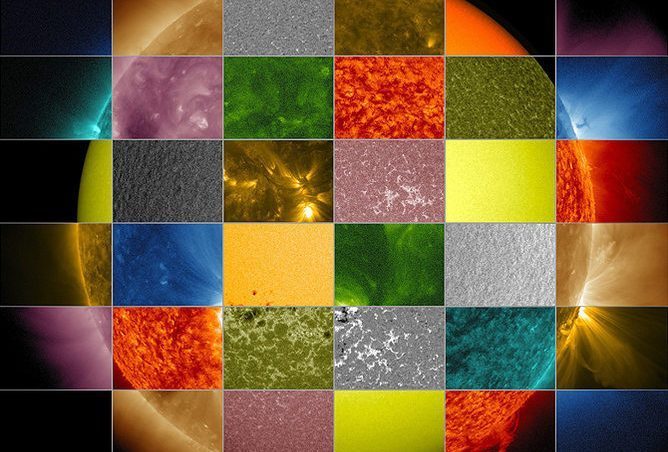
© NASA/SDO/Goddard Space Flight Center
Professor Valentina Zharkova's full paper released June 24 entitled, 'Oscillations of the Baseline of Solar Magnetic Field and Solar Irradiance on a Millennial Timescale' has been
accepted for publishing in Nature. It confirms a Grand Solar Minimum from 2020 to 2055, as all four magnetic fields of the sun go out of phase, while now also suggesting centuries of
natural warming post-Minima.
Zharkova's team's expanded 'double dynamo' calculations match-up almost perfectly with the timelines of past Grand Minimas: the Maunder Minimum (1645-1715), Wolf minimum (1300-1350), Oort minimum (1000-1050), Homer minimum (800-900 BC); as well as with the past Grand Maximas: the Medieval Warm Period (900-1200), the Roman Warm Period (400-150 BC), and so on.
Now, following the well-documented
super Grand Solar Minimum cycle (2020-2055), and coming somewhat as a surprise,
Zharkova's analysis goes on to suggest the sun will then enter a 300+ year spell of increased-activity, actually warming the earth at a rate of 0.5C (0.9F) per century, running until the next GSM cycle (2370-2415).
And then succeeding that cooling period, from 2415, the world, according to Zharkova, will continue on with its warming trend, again at an average of 0.5C (0.9F) per century,
until the year 2600 when the sun will flip to a prolonged cooling phase running for the next 1000 years (and likely propelling Earth into the next ice age).It is a little confusing why
Zharkova failed to mention these long spells of warming (2055-2370 and then 2415-2600) in her original 'teaser' presentation back in October, 2018. Whether it has been included to continue her funding and/or to see her GSM message reach a wider audience is honestly anyone's guess.
Though to her credit, at least the 0.5C (0.9F) warming per century is driven by the sun, and not you, not CO2.
Zharkova's work, at worst, confirms that the earth warms and cools as a part of complex natural cycles.
For a more detailed look at the paper, click here for tallbloke's breakdown.And, to me at least, it remains a fair takeaway that regardless of what happens
post-2055, that 35 year cooling period beginning 2020 should be enough to give almost-every living organism on the planet cause for concern.
Historically, life hasn't done too well in the cold:
Our star is effectively shutting down, starting next year (2020).The upcoming GSM is forecast (by Zharkova herself, among others) to be
similar to the Maunder Minimum (1645-1715) — a time when sunspots were exceedingly rare and much of the planet experienced colder than average temperatures.We are already seeing an increase in unstable weather patterns, as the weakest solar cycle in over 100 years (SC24) continues to weaken the jet stream, reverting it's usual zonal (tight) flow to more of a meridional (wavy) one.
Major flooding, snowstorms, anomalous cold and bursts of unseasonable heat are all contributing to one of the poorest growing years on record for the farmers around the globe.An uptick in high-level volcanic eruptions is also associated with low solar activity. Increasing Cosmic Rays are believed to heat the muons in subsurface silica-rich magma (
click here for more on that). And larger eruptions (ones that fire volcanic ash above 32,800 feet (10 km) and into the Stratosphere) have a direct cooling effect on the planet, as these ejected particulates effectively block out the sun.
An influx of Cosmic Rays (caused by a decrease in deflecting solar winds) also nucleate more clouds (Svensmark) and these play an major role in earth's climate:
"Clouds are the Earth's sunshade, and if cloud cover changes for any reason, you have global warming — or global cooling." — Roy W. Spencer PhD.
Unfortunately, things are only expected to get worse,
until 2055 at least, with now even NASA joining in the fun with their latest SC25 forecast suggesting it'll be the weakest cycle for the last 200 years, continuing the solar shutdown:
The agency is effectively forecasting a return to the Dalton Minimum (1790-1830) without giving mention to the brutal cold, crop loss, famine, war and powerful Volcanic eruptions associated with it.
The year 1816 went on to earn the name, "Eighteen Hundred and Froze to Death" (
see the link below).
The cold times are returning.
The next Solar Cycle (25) is likely just a stop-off on our descent into the next
super Grand Solar Minimum cycle.
Prepare.
Your comments are appreciated.